The insulator EACBE regulates V(D)J recombination of Tcrd gene by modulating chromatin organization
- PMID: 40746544
- PMCID: PMC12310595
- DOI: 10.3389/fimmu.2025.1613621
The insulator EACBE regulates V(D)J recombination of Tcrd gene by modulating chromatin organization
Abstract
T cell receptor (TCR) diversity, essential for the recognition of a wide array of antigens, is generated through V(D)J recombination. The Tcra and Tcrd genes reside within a shared genomic locus, with Tcrd rearrangement occurring first in the double-negative (DN) stage during thymocyte development. Elucidating the regulatory mechanisms governing Tcrd rearrangement is therefore crucial for understanding the developmental coordination of both Tcrd and Tcra rearrangements. Chromatin architecture, orchestrated by CTCF-cohesin complexes and their binding sites, plays a fundamental role in regulating V(D)J recombination of antigen receptor genes. In this study, we report that EACBE, a CTCF binding element (CBE) located downstream of the Tcra-Tcrd locus, regulates Tcrd rearrangement. EACBE promotes the usage of proximal Vδ gene segments by facilitating spatial proximity between the Tcrd recombination centre and these Vδ elements. Notably, EACBE counteracts the insulating effects of INTs, two CBEs that demarcate the proximal V region from the Dδ-Jδ-Cδ cluster, thereby enabling effective chromatin extrusion. Furthermore, EACBE indirectly shapes the Tcra repertoire through its influence on Tcrd rearrangement. These findings reveal a novel regulatory axis involving special chromatin configuration and highlight distinct roles for specific CTCF binding sites in modulating antigen receptor gene assembly.
Keywords: CTCF binding element; T cell receptor; V(D)J recombination; chromatin activity; chromatin architecture.
Copyright © 2025 Zhu, Dai, Zhao, Luo, Li, Xue, Qin, Pan, Liao and Hao.
Conflict of interest statement
The authors declare that the research was conducted in the absence of any commercial or financial relationships that could be construed as a potential conflict of interest.
Figures
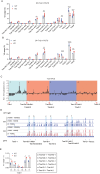
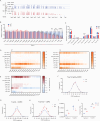
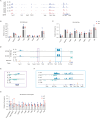
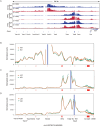
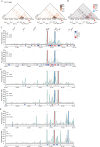
Similar articles
-
An Ectopic CTCF Binding Element Inhibits Tcrd Rearrangement by Limiting Contact between Vδ and Dδ Gene Segments.J Immunol. 2016 Oct 15;197(8):3188-3197. doi: 10.4049/jimmunol.1601124. Epub 2016 Sep 9. J Immunol. 2016. PMID: 27613698 Free PMC article.
-
A role of the CTCF binding site at enhancer Eα in the dynamic chromatin organization of the Tcra-Tcrd locus.Nucleic Acids Res. 2020 Sep 25;48(17):9621-9636. doi: 10.1093/nar/gkaa711. Nucleic Acids Res. 2020. PMID: 32853367 Free PMC article.
-
Dynamic O-GlcNAcylation governs long-range chromatin interactions in V(D)J recombination during early B-cell development.Cell Mol Immunol. 2025 Jan;22(1):68-82. doi: 10.1038/s41423-024-01236-9. Epub 2024 Dec 3. Cell Mol Immunol. 2025. PMID: 39627609
-
Chromatin Dynamics and the Development of the TCRα and TCRδ Repertoires.Adv Immunol. 2015;128:307-61. doi: 10.1016/bs.ai.2015.07.005. Epub 2015 Aug 15. Adv Immunol. 2015. PMID: 26477370 Review.
-
Chromatin insulator mechanisms ensure accurate gene expression by controlling overall 3D genome organization.Curr Opin Genet Dev. 2024 Aug;87:102208. doi: 10.1016/j.gde.2024.102208. Epub 2024 May 28. Curr Opin Genet Dev. 2024. PMID: 38810546 Free PMC article. Review.
References
MeSH terms
Substances
LinkOut - more resources
Full Text Sources

